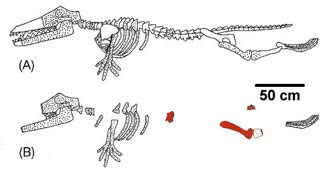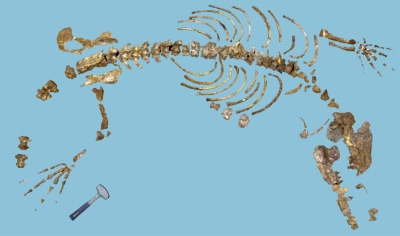Ambulocetus natans
It lived about 50 million years ago, during the early Eocene.The specimen was found in eastern Pakistan by Thewissen
et al,(Northeastern Ohio University College of Medicine), who
popularized the idea that this creature was an early, amphibious
ancestor of whales. It is actually a land creature that evolutionists
have insisted on ‘turning into a whale.’
The name Ambulocetus natans comes from the Latin words ‘ambulare’ (to walk), ‘cetus’ (whale) and ‘natans’ (swimming), and means ‘a walking and swimming whale.’
It is obvious the animal used to walk because it had four legs, like all other mammals, and even wide claws on its feet and hooves on its hind legs. Apart from evolutionists’ prejudice however, there is absolutely no basis for the claim that it swam in water, or that it lived on land and in water (like an amphibian).
In order to see the border between science and wishful imagination on this subject, let us have a look at National Geographic’s reconstruction of Ambulocetus. This is how it is portrayed in the magazine:

Fake drawings: Imaginary webs added to claws, and rear legs made to look like fins.
If you look at it carefully you can easily see the two little visual manipulations that have been employed to ‘turn the land-dwelling Ambulocetus into a whale:
-
The animal’s rear legs are shown not with feet that would help it to
walk, but as fins that would assist it to swim. However, Carroll, who
examines the animal’s leg bones, says that it possessed the ability to
move powerfully on land.[5]
-
In order to present an impression of adaptation for water, webbing
has been drawn on its front feet. Yet it is impossible to draw any such
conclusion from a study of Ambulocetus fossils. In the fossil
record it is next to impossible to find soft tissues such as these. So
reconstructions based on features beyond those of the
skeleton are always speculative. That offers evolutionists a wide-ranging empty space of speculation to use their propaganda tools.
In publishing the picture of the animal’s skeleton, National Geographic had to take a step back from the retouching it had carried out to the reconstruction picture which made it seem more like a whale. As the skeleton clearly shows, the animal’s feet were designed to carry it on land. There was no sign of the imaginary webs.

(A) Imaginary drawing of Ambulocetus, ‘at the end of the power stroke during swimming’, by Thewissen et al.
(B) The stippled bones were all that were found. And the bones coloured red were found 5 m above the rest. With the ‘additions’ removed there really isn’t much left of Ambulocetus!
The evolutionary biologist Annalisa Berta commented on the Ambulocetus fossil (in 1994):
'Since the pelvic girdle is not preserved, there is no direct evidence in Ambulocetus
for a connection between the hind limbs and the axial skeleton. This hinders interpretations
of locomotion in this animal, since many of the muscles that support and move the hindlimb originate on the pelvis'
In 1996, More remains were found:for a connection between the hind limbs and the axial skeleton. This hinders interpretations
of locomotion in this animal, since many of the muscles that support and move the hindlimb originate on the pelvis'
The shock:

Figure : All the material found of Ambulocetus natans (from: http://www.neomed.ed...gins/index.html)- The ONLY known fossil in the world - This animal is known solely from a single, partial skeleton, that of an individual about 3 meters (~10 feet) long!
EUGENE M. MCCARTHY, PHD commented:
The actual evidence for such a claim is actually rather meager. Here are the few points usually cited in support of this assertion:
- It is supposedly whalelike because it had a nose that allowed it to swallow underwater.
- However, human beings and many other non-marine organisms can swallow underwater.
- Moreover, as can be seen figure above , the snout of the single known specimen was not preserved.
- The periotic bone, which surrounds the inner ear in mammals, is
supposedly whalelike, allowing ambulocetids to hear well in water.
- But no one actually knows how well these creatures could hear, whether in water or out of it.
- Moreover, little or nothing is usually said about the great dissimilarity between all of the other features of this animal and those of a whale.
- Its teeth are alleged to be like those of a whale.
- But the jaws of the single individual known (again see the figure above) are highly fragmented, and the few teeth preserved appear to differentiated, unlike those of toothed whales.
- It is asserted that Ambulocetus's hindlimbs were ill-adapted to terrestrial locomotion. But the limbs — and the pelvis — are so poorly preserved (see high resolution image), that it seems there is no clear evidence bearing on this point.
- Known fossils are from the Eocene and are already quite whalelike. Ambulocetus
(Thewissen and Aria 1994; Thewissen et al. 1996) cannot be counted as a transitional form because it is actually younger than the oldest rcognized cetacean Himalayacetus (Bajpa and Gingerich 1998). The evolution of whales from forms that are younger than the earliest known whales clearly isn't possible.
The jawbone of an ancient whale found in Antarctica may be the oldest fully aquatic whale yet discovered.
10/11/2011
With this new fossil find, however, dating to 49 million years ago (bear in mind that Pakicetus lived around 53 million years ago), this means that the first fully aquatic whales now date to around the time when walking whales (Ambulocetus) first appear.
www.nbcnews.com/id/44867222/ns/technology_and_science-science/
N.B:
Wikipedia is unreliable source for any information related to evolution.

Strange creature. If the reconstruction showing webbed appendages is wrong then what do others think it looked like? Why is there nothing like this on Earth?
ReplyDelete